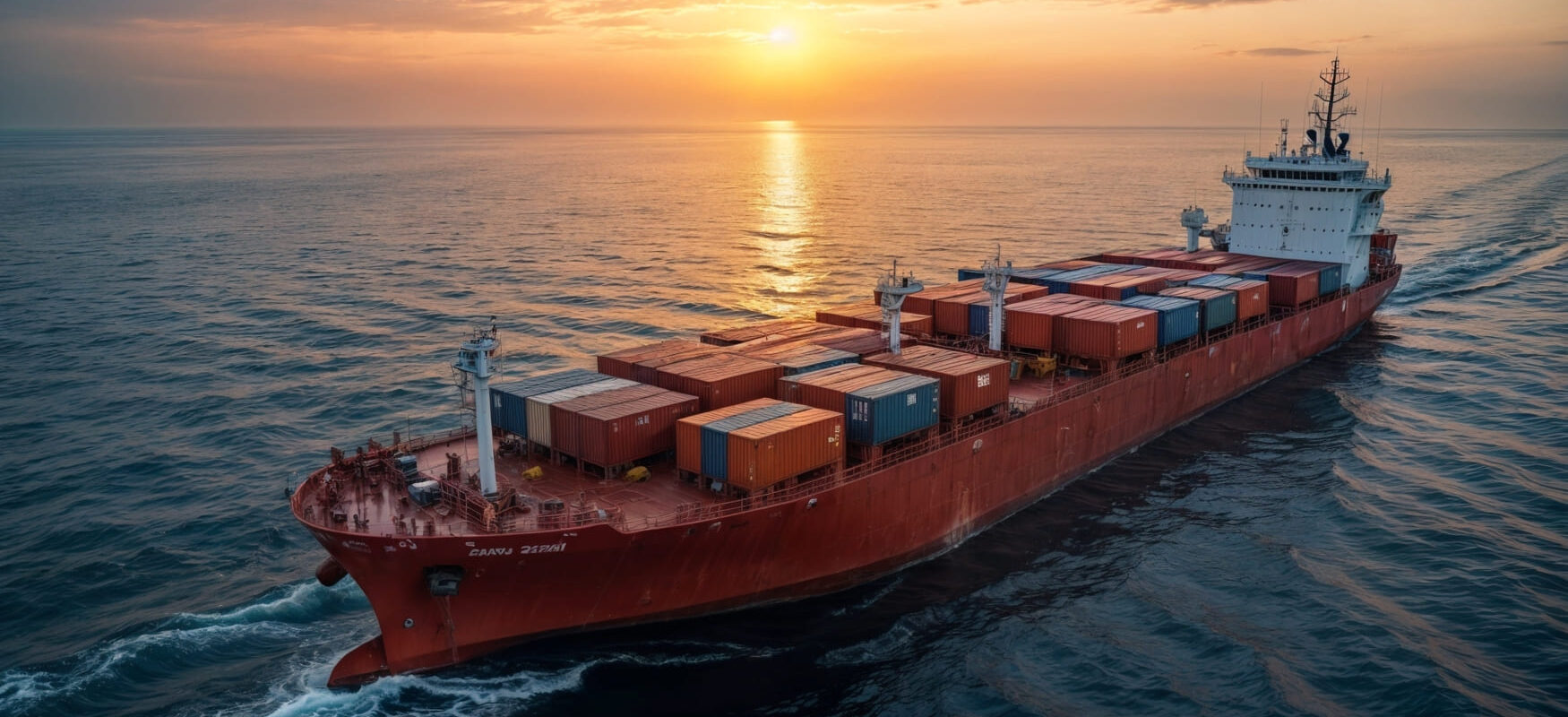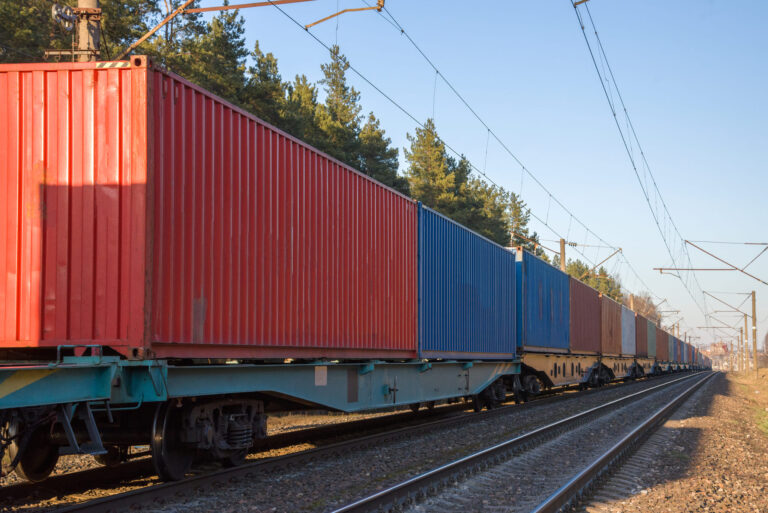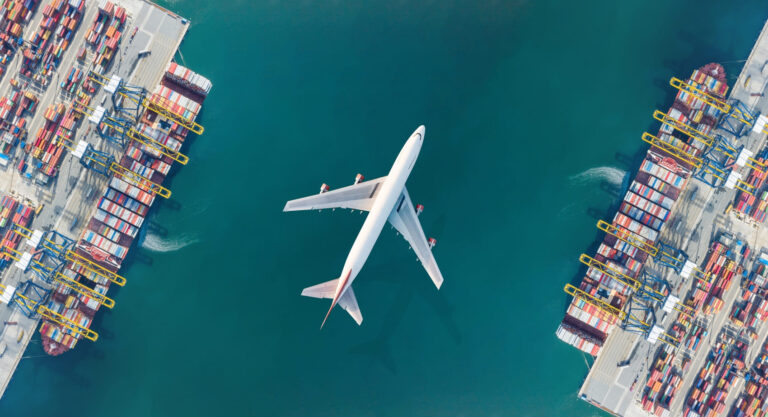Intermodal Shipping: The Smart, Efficient Way to Move Freight

Intermodal shipping refers to moving freight by two or more transportation modes (truck, rail, ship, etc.) using standardized containers. Cargo stays sealed inside its container during transfers, reducing handling and speeding up delivery. This containerized approach cuts costs and transit time for long-distance shipments, making intermodal freight shipping a cost-efficient, secure method to move goods.
What Is Intermodal Shipping?
Intermodal shipping means using multiple modes, for example, a truck and train, to carry one shipment without unpacking the cargo. In international intermodal, 20- or 40-foot containers are loaded onto ships, then transferred directly to trucks or trains at the port. The container stays sealed the whole way. In domestic intermodal, 53-foot containers are used for inland moves: goods arrive at a port in smaller containers, then are transloaded into 53-foot vans at a cross-dock or transload facility before being shipped inland. In all cases, intermodal shipments let goods flow seamlessly between ships, railcars, and trucks without repacking.
How Intermodal Shipping Works (Container Shipping Process)
Here’s how a typical intermodal shipment moves freight step by step:
- Origin pickup (Drayage): A truck (drayage carrier) picks up a loaded container on a chassis trailer and hauls it to a nearby intermodal terminal or port. This short-distance move is often 15–50 miles.
- Modal transfer: At the terminal, cranes lift the container off the truck. It is loaded onto a railcar (well car or flatcar) or directly onto a ship for the long-haul leg. (For example, at a port the container may go from ship to train or truck without unloading.)
- Long-haul rail/ocean: The container travels the bulk of its journey by rail or ship. On trains, containers can be double-stacked for efficiency. On ocean vessels, they are stacked in slots like Lego blocks.
- Destination transfer: Upon arrival at a destination terminal or inland rail yard, the container is lifted from the train or ship and placed on a truck chassis.
- Final delivery: A drayage truck carries the container to the consignee’s warehouse, distribution center, or store. The container is then unloaded, completing the journey.
This intermodal sequence minimizes unloading: the container itself is the unit that moves between modes. By handling the cargo only at origin and destination, shippers avoid extra labor, damage and delays.
Benefits of Intermodal Freight Transportation

Intermodal shipping offers multiple advantages over single-mode (truck-only) transport:
- Lower Cost Over Long Distances: Using rail or ship for the long-haul leg greatly reduces costs. For example, shipping 100 truckloads from Los Angeles to Chicago via intermodal (truck-rail-truck) can save on the order of $100K+ per year. Rail and ocean carriers have lower per-ton-mile rates than trucks, so high-mileage moves yield big savings.
- Fuel Efficiency & Sustainability: Freight trains are extremely fuel-efficient. A U.S. railroad can move one ton of cargo 470–500 miles on a single gallon of fuel. In practice, one fully loaded intermodal train can take ~280 trucks off the highway. This means far less fuel burned and lower CO₂ emissions. For example, shifting 100 truckloads from LA–Chicago to intermodal rail would avoid over 200 metric tons of CO₂ yearly. In other words, intermodal is a greener choice for long hauls.
- High Capacity & Reliability: A single train carries many containers at once, and carriers often offer scheduled, consistent service. This “economy of scale” makes capacity more available in tight markets. Major U.S. railroads maintain 100,000+ domestic containers in shared pools, and intermodal schedules are typically reliable. Shippers can lock in capacity (e.g. through railroads’ commitment programs) and get steady, year-round pricing and space.
- Reduced Handling & Risk: Because the cargo stays in the same sealed box, there’s less handling at transfers, which reduces damage and loss. Containers are locked and tracked from origin to destination, improving security and reliability. Terminals and ramps add security inspections at transfer points, so intermodal freight is generally very safe.
- Best of Multiple Modes: Intermodal lets shippers combine the strengths of each mode. For example, trains are cheaper and cleaner for the middle mile, while trucks give flexibility for origin/destination pickup and delivery. With intermodal, a shipper can avoid building rail facilities at every site: the railroad hauls the freight long distances, and trucks handle the first/last mile to and from any off-rail location. This flexibility helps bypass congestion (e.g. ports or cities) by routing via rail hubs if needed.
Intermodal Transportation: Containers and Tank Containers
At the heart of intermodal shipping are ISO containers, standard steel cargo boxes. These come in fixed sizes: typically 20‑ft and 40‑ft for international, and 53‑ft for domestic U.S. moves. They’re built to ISO specifications, with uniform dimensions and corner fittings so cranes and chassis worldwide can handle them seamlessly. Most containers are made of corrugated steel (durable for ocean voyages and stacking) with secure locking doors; some are refrigerated for perishables. Because of this standardization, a container loaded at a factory can travel on a ship, then a train, then a truck, all without ever repacking.
Containers are also known by many names – shipping containers, freight containers, ISO boxes, or simply “boxes.” Regardless of terminology, they streamline global trade by keeping cargo intact across modes.
Specialized Intermodal Tanks: Some containers are cylindrical ISO tanks designed for liquids (fruit juices, chemicals, etc.). These intermodal tank containers (ISO tanks) are typically 20‑ft or 40‑ft long and ISO‑standard diameter. They function just like box containers: an ISO tank is loaded with liquid, sealed, and then transferred between ships, trains, and trucks without emptying the cargo. This makes them shipping units, not fixed-site storage. In other words, ISO tanks are built to transport fluids, they move by rail or truck when on the road, and stack on ships like other containers. (That said, a tank container may sit at a yard or facility briefly as temporary storage, but its primary role is in transit.)
Are intermodal tanks shipping or storage vehicles? They are shipping containers by design. They carry bulk liquids through the supply chain. Like any container, they may be stored at a terminal or warehouse along the way, but they are never permanently fixed, they stay on chassis, rail cars or ships until opened at the destination.
Intermodal Rail and Carriers
Most long-haul intermodal moves rely on railroads as the core carriers. In North America, the Class I railroads (Union Pacific, BNSF, CSX, etc.) operate extensive containerized networks. Collectively, these railroads share a fleet of over 100,000 domestic 53-foot containers, which they interchange nationwide. A typical container might hop from one railroad to another via interchange terminals. Intermodal containers travel on special flat cars or well cars that can double-stack them for efficiency.
Shippers usually work with intermodal carriers or logistics firms (called intermodal marketing companies, or IMCs) that book space on these rail networks. Some carriers are asset-based (own their own containers and drayage trucks) and others are non-asset 3PLs that contract with the railroads. All these carriers coordinate the multimodal journey under multiple contracts. Importantly, even if a factory or warehouse isn’t directly on a rail line, intermodal carriers connect it: truck drayage handles first/last mile, linking the site to the nearest intermodal ramp or port.
In practice, intermodal rail offers the broad reach and large capacity of trains, while specialized drayage carriers handle the short-haul legs. A railroads’ intermodal service is only as useful as its drayage connections. That’s why shippers often rely on providers who manage drayage trucks to and from ports, rail terminals, and inland distribution points.
Integrated Services: Warehousing, Transloading, and Drayage
To fully leverage intermodal shipping, complementary logistics services are key:
- Transloading: This is the process of moving cargo into or out of containers at a warehouse or rail yard. Olimp’s transloading services specialize in container offload and reloading. For example, a 20-foot ocean container arriving at a U.S. port can be unloaded at a nearby transload warehouse. Goods are then consolidated onto trucks, trailers, or even 53-foot domestic containers for the next leg. This avoids empty container returns and lets shippers quickly get cargo onto the most efficient mode (truck or rail) for its destination.
- Drayage: Drayage covers the short-haul trucking between ports, rail yards, airports, and nearby warehouses. Olimp’s drayage teams provide coast-to-coast drayage at major U.S. ports and airports. For example, they’ll pick up an incoming ocean container at the port and move it to a cross-dock or rail ramp. Because drayage trucks specialize in these “first/last mile” legs, they know port rules and can operate within tight terminals, preventing costly delays. In intermodal shipping, drayage is literally the backbone of logistics, it bridges gaps between modes and keeps containers moving.
- Warehousing: Warehouses serve as flexible storage or staging points in the intermodal chain. Olimp has thousands of partner warehouses across North America. These can temporarily hold container cargo (short- or long-term) and provide value-added services (palletizing, inventory management, etc.). By leveraging nearby warehouse space, a shipper can pull goods inland if needed, buffer seasonal spikes, or handle last-minute diversions – all critical for a smooth intermodal operation.
By combining these services, shippers create an end-to-end intermodal supply chain. For instance, a typical flow might be: an inbound container arrives at port, Olimp’s drayage brings it to a nearby transload warehouse, cargo is sorted and put into domestic containers or trailers, those then move by rail to another hub, and the final pieces are delivered by drayage truck to the end customer. Along the way, any excess goods can be stored in warehouse racks. This integrated approach leverages the strengths of intermodal, fast rail movement and flexible trucking, while keeping freight accessible via warehouses.
Getting Started with Intermodal Shipping
Intermodal shipping is an effective way to move freight smartly and sustainably. By keeping cargo sealed in ISO containers, combining rail and truck (or ship) segments, and minimizing handling, shippers achieve cost savings, higher capacity, and greener operations. To use intermodal, evaluate your lanes (typically long-hauls over 500+ miles are good candidates) and consider the proximity of origin/destination to intermodal ramps or ports. Working with an experienced intermodal provider is key, they’ll arrange the drayage, book rail space, and coordinate transloading or warehousing as needed.
At Olimp Warehousing, we integrate intermodal into our logistics solutions. Our nationwide transloading network ties in with major rail hubs, and our drayage fleets ensure containers get to and from those ramps. Meanwhile, our warehousing platform provides storage and cross-dock options wherever your container lands. The result is a seamless intermodal chain: you get the efficiency of rail and flexibility of trucking without the hassle of managing each piece yourself.
In summary, intermodal shipping – shipping containers moved by multiple modes – is a smart, efficient freight solution. It drives down costs and emissions while improving reliability. To learn more about container types and intermodal terms, see resources like Intermodal Freight Transport on Wikipedia. And when you’re ready to implement intermodal, our warehousing, transloading and drayage services are here to link every leg of your supply chain.
Frequently Asked Questions (FAQ) – OLIMP Warehousing
Q: What is intermodal shipping?
It’s the movement of freight in the same container across multiple transport modes—truck, rail, ocean, and even air—without handling the cargo itself during mode changes.
Q: When should businesses use intermodal vs. trucking?
It’s cost-effective over longer distances (typically 700+ miles), especially for high-volume lanes; otherwise, trucking may be cheaper.
Q: How much money can intermodal save?
Typical savings range from 15–30% compared to over‑the‑road trucking, depending on variables like fuel, distance, and volume.
Q: How long does intermodal transit take?
Standard service averages ~600 mi/day; expedited ~800 mi/day. For instance, LA to Chicago (~2,000 mi) can be done in ~3 days with Express service.
Q: Who provides door-to-door intermodal service?
Class I railroads (e.g., BNSF, UP) work with motor carriers or asset-based IMCs to deliver door-to-door service.
Q: What about tracking and visibility?
ISO container IDs, tracking tools, API integrations, and AI help provide real-time updates and reliable ETAs.
Q: Are there restrictions on what you can ship?
Generally anything non-hazardous and containerizable; refrigeration units are available for perishable goods. Hazardous items may have restrictions.
Q: What are accessorial charges?
Fees such as drayage (truck-to-rail), fuel surcharges, demurrage, and per diems are added to base linehaul rates.
You may be interested in

What Are Intermodal Containers? A Guide to Types, Uses & Benefits
Intermodal containers, also known as shipping containers or ISO containers are large, standardized metal boxes used to transport goods across multiple modes of transportation (ship, rail, and truck) without unloading the cargo inside. These containers are the backbone of global trade, allowing products to seamlessly travel from a factory floor to an overseas ship, onto […]

Intermodal Drayage: Definition, Benefits, and Key Differences
For shippers and logistics managers, intermodal drayage is the short-haul trucking segment of a longer freight route. It involves moving containers by truck between ports, rail terminals, and warehouses-typically within a 15–50 mile radius. This first-mile/last-mile trucking leg bridges larger shipping modes (ships, trains, and trucks), keeping cargo flowing smoothly and reducing port congestion. Intermodal […]

Mastering Air Freight Shipping: 10 Steps to Global Logistics Success
In an international freight shipping strategy, air freight shipping is prized for its speed and reliability. Air freight, the process of transporting goods by aircraft, is ideal for time-sensitive or high-value shipments, enabling businesses to meet tight delivery deadlines. Compared to ocean or ground transport, air shipping dramatically shortens transit times. However, this speed comes […]
Ready to streamline your warehousing needs?
Request a quote today and discover how OLIMP's tailored solutions can optimize your operations